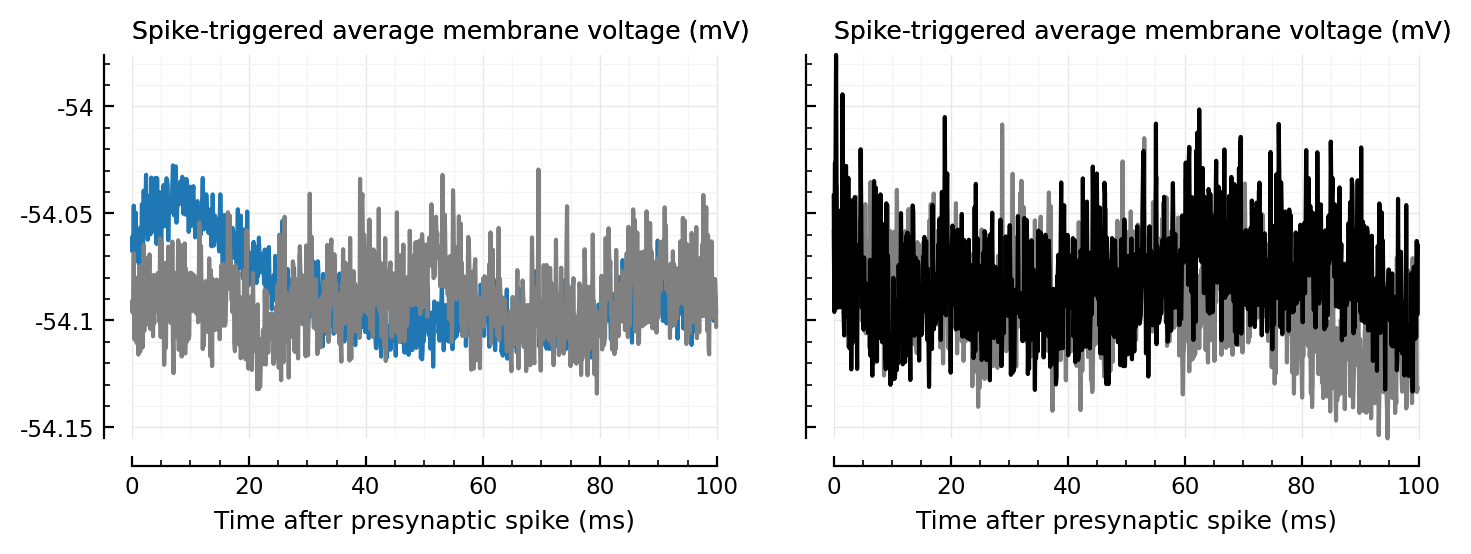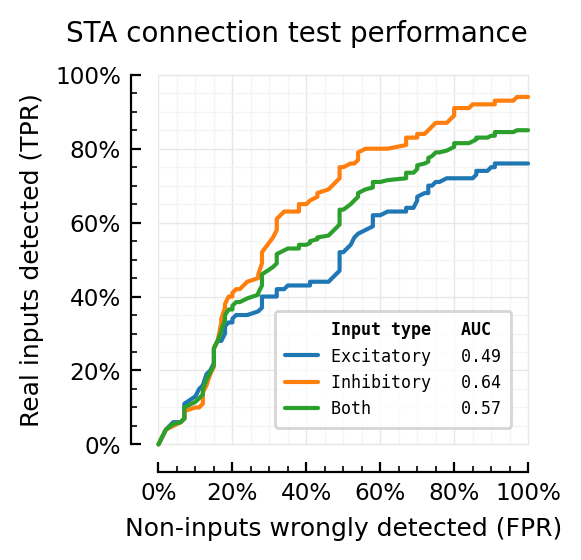2023-08-31__STA_conntest
Contents
2023-08-31__STA_conntest¶
So, hi. copying from prev nb:
So, for all 10 Ns;
For 10 diff seeds;
for both exc, inh, and unconn;
we conntest (maximum) 100 input spike trains.
(Each test is comprised of calculating 101 STAs: one real and the rest with shuffled ISIs).
include("lib/Nto1.jl")
using Revise … ✔
using Units, Nto1AdEx, ConnectionTests, ConnTestEval … ✔
using StatsBase … ✔
duration = 10minutes
N = 6500
@time sim = Nto1AdEx.sim(N, duration);
3.184070 seconds (2.14 M allocations: 1.027 GiB, 2.32% gc time, 42.19% compilation time)
(So even with native code caching in Julia 1.9, we still have 30% of time compilation here).
We decided we’d pick the 100 highest firing (exc and inh).
And then generate some unconnecteds too..
What’s their firing rate? Maybe sample from the real ones :) hehe, sure.
Gen unconnected trains¶
exc_inputs = highest_firing(excitatory_inputs(sim))[1:100]
inh_inputs = highest_firing(inhibitory_inputs(sim))[1:100]
both = [exc_inputs..., inh_inputs...]
fr = spikerate.(both)
showsome(fr / Hz)
200-element Vector{Float64}:
1: 97.5
2: 58.9
⋮
31: 21.5
⋮
146: 12.5
⋮
199: 8.87
200: 8.86
Random.seed!(1)
unconn_frs = sample(fr, 100)
showsome(unconn_frs)
100-element Vector{Float64}:
1: 25.9
2: 17.1
⋮
19: 17.7
⋮
72: 11
⋮
99: 10.4
100: 8.92
Seed may not be same as seed in sim: otherwise our ‘unconnected’ trains generated might be same as real ones used in (generated in) sim.
Random.seed!(9)
unconn_trains = [poisson_SpikeTrain(r, duration) for r in unconn_frs];
Conntest¶
ConnectionTests.set_STA_length(200); # = 20 ms
test(train) = test_conn(STAHeight(), sim.V, train.times)
@time test(exc_inputs[1])
1.280038 seconds (1.58 M allocations: 240.340 MiB, 4.21% gc time, 58.25% compilation time)
0.94
(That value is the ‘connectedness measure’ I defined. Here simply 1 – p-value)
Plottin some unconnected STAs.
include("lib\\plot.jl")
import PythonCall … ✔ (2.3 s)
import PythonPlot … ✔ (6 s)
using Sciplotlib … ✔ (0.6 s)
using PhDPlots … ✔
_plotSTA(train, winlength = 1000; kw...) = plotSTA(calc_STA(sim.V, train.times, Nto1AdEx.Δt, winlength); kw...);
fig, axs = plt.subplots(ncols=2, figsize=(pw, 0.3pw), sharey=true)
_plotSTA(exc_inputs[1], ax=axs[0])
_plotSTA(unconn_trains[1], ax=axs[0], c="gray")
_plotSTA(unconn_trains[2], ax=axs[1], c="gray")
_plotSTA(unconn_trains[3], ax=axs[1], c="black");

@time test.(unconn_trains[[1,2,3]])
0.653168 seconds (87.31 k allocations: 84.142 MiB, 10.37% compilation time)
3-element Vector{Float64}:
-0.01
-0.02
-0.94
include("lib/df.jl")
using DataFrames … ✔ (0.9 s)
using ProgressMeter
rows = []
@time for (conntype, trains) in [
(:exc, exc_inputs),
(:inh, inh_inputs),
(:unc, unconn_trains)
]
descr = string(conntype)
@showprogress descr for train in trains
t = test(train)
fr = spikerate(train)
push!(rows, (; conntype, fr, t))
end
end;
exc 100%|████████████████████████████████████████████████| Time: 0:00:23mm39mm
inh 100%|████████████████████████████████████████████████| Time: 0:00:16
unc 100%|████████████████████████████████████████████████| Time: 0:00:20
60.244557 seconds (1.78 M allocations: 7.140 GiB, 1.40% gc time, 2.27% compilation time)
showsome(rows)
300-element Vector{Any}:
1: (conntype = :exc, fr = 97.5, t = 0.94)
2: (conntype = :exc, fr = 58.9, t = 0.95)
⋮
34: (conntype = :exc, fr = 21.1, t = 0.86)
⋮
167: (conntype = :inh, fr = 10.4, t = 0.93)
⋮
299: (conntype = :unc, fr = 10.3, t = 0.6)
300: (conntype = :unc, fr = 8.81, t = 0.39)
df = DataFrame(rows)
rename!(df, :fr => "Spikerate (Hz)")
| Row | conntype | Spikerate (Hz) | t |
|---|---|---|---|
| Symbol | Float64 | Float64 | |
| 1 | exc | 97.5 | 0.94 |
| 2 | exc | 58.9 | 0.95 |
| 3 | exc | 40.7 | 0.99 |
| 4 | exc | 34.4 | 0.54 |
| 5 | exc | 31.5 | 0.87 |
| ⋮ | ⋮ | ⋮ | ⋮ |
| 296 | unc | 9.21 | 0.94 |
| 297 | unc | 16.4 | 0.29 |
| 298 | unc | 8.98 | -0.96 |
| 299 | unc | 10.3 | 0.6 |
| 300 | unc | 8.81 | 0.39 |
Eval¶
sweep = ConnTestEval.sweep_threshold(df);
showsome(sweep.threshold)
96-element Vector{Float64}:
1: 0.99
2: 0.98
⋮
39: 0.6
⋮
79: 0.19
⋮
95: 0.01
96: 0
23/100
0.23
predtable = at_FPR(sweep, 5/100)
print_confusion_matrix(predtable)
Predicted
exc inh unc
exc 6 2 92
Real inh 0 6 94
unc 4 2 94
AUCs = calc_AUROCs(sweep)
AUCs = (; (k=>round(AUCs[k], digits=2) for k in keys(AUCs))...)
(AUC = 0.57, AUCₑ = 0.49, AUCᵢ = 0.64)
Damn! This was when not ceiling spikes:
Predicted
exc inh unc
exc 23 3 74
Real inh 0 40 60
unc 4 2 94
(AUC = 0.77, AUCₑ = 0.68, AUCᵢ = 0.86)
fig, ax = plt.subplots()
# ax.axvline(0.05, color="gray", lw=1)
plot(sweep.FPR, sweep.TPRₑ; ax, label="Excitatory $(AUCs.AUCₑ)")
plot(sweep.FPR, sweep.TPRᵢ; ax, label="Inhibitory $(AUCs.AUCᵢ)")
plot(sweep.FPR, sweep.TPR; ax, label="Both $(AUCs.AUC)")
set(ax, aspect="equal", xlabel="Non-inputs wrongly detected (FPR)", ylabel="Real inputs detected (TPR)",
xtype=:fraction, ytype=:fraction, title=("STA connection test performance", :pad=>12, :loc=>"right"))
font = Dict("family"=>"monospace", "size"=>6)
legend(ax, borderaxespad=1, title="Input type AUC ", loc="lower right",
alignment="right", markerfirst=true, prop=font);
# Using the same `font` dict for `title_fontproperties` does not apply the size (bug ig)
# (bug in this PR? https://github.com/matplotlib/matplotlib/pull/19304)
# Hm, it works in straight Python[*]. Interesting.
ax.legend_.get_title().set(family="monospace", size=6, weight="bold");

[*]: http://localhost:8888/notebooks/2023-09-05__mpl_legend_title_props_bugreport.ipynb
(below not updated after adding ceil_spikes=true)
neighbours_of_5pct_line = sweep[5:6]
neighbours_of_5pct_line.threshold
2-element Vector{Float64}:
0.95
0.94
neighbours_of_5pct_line.FPR
2-element Vector{Float64}:
0.03
0.06
Sudden jump in TPRs right around 5%.
Coincidence I think, cause there is no threshold programmed in STAHeight ConnectionTest.
Actually no, jump is after 5% / at 6%:
x = sweep[5:11]
DataFrame(; x.threshold, x.FPR, x.TPR)
| Row | threshold | FPR | TPR |
|---|---|---|---|
| Float64 | Float64 | Float64 | |
| 1 | 0.95 | 0.03 | 0.28 |
| 2 | 0.94 | 0.06 | 0.315 |
| 3 | 0.93 | 0.06 | 0.335 |
| 4 | 0.92 | 0.06 | 0.4 |
| 5 | 0.91 | 0.06 | 0.44 |
| 6 | 0.9 | 0.06 | 0.465 |
| 7 | 0.89 | 0.07 | 0.48 |
So we increase the threshold from 0.94 to 0.90, and find more TPs, without incurring any additional FPs.